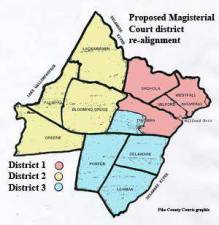One year, 5,501 new residents: Pike’s pandemic-induced growth leads president judge to ask for re-establishment
Milford. On the high end of the workload spectrum is the Magisterial District Court that serves Shohola, Lackawaxen, and Dingman, the county’s most populous municipality. Pennsylvania requires that Magisterial District Courts undergo a redistricting process in the year following the federal Census.


After reviewing the caseload and workload of the Pike County Court of Common Pleas, President Judge Gregory Chelak has found a long and steady increase in the county’s population growth, especially after national crises like 9/11 and the Covid-19 pandemic.
Pennsylvania requires that Magisterial District Courts undergo a redistricting process, referred to as re-establishment, in the year following the federal Census. The Supreme Court of Pennsylvania has directed the president judge of each judicial district to submit by Feb. 28 a recommendation on whether to re-establish their local Magisterial District Courts. President Judge Chelak on Jan. 28 recommended the re-establishment of the county’s four courts, and their offices,
He is recommending that the courts be re-established in their current form, after considering both the guidelines submitted by the Supreme Court and the following factors:
● Pike County has been one of the fastest-growing counties in the state for more than two decades. From 2000 to 2010, the county population grew by 23 percent, from 46,000 to 60,317, as the result of 9/11, according to Judge Chelak’s recommendation. In 2021, the second year of the pandemic, Pike County recorded 5,501 house and land sale deed transactions.
● The increase in population has led to an increase in caseload and workload of the county’s Magisterial District Courts during that time.
● Each Magisterial District Court experiences fluctuations in caseload tied to such factors as commercial development, community association activity, local police departments, all of which are difficult to accurately predict. However, the influx of new residents from New York and New Jersey during the pandemic, and their ability to work remotely, “it is reasonably expected that these trends will continue,” with future growth expected to exceed that from 2000-10.
Based on Judge Chelak’s recommendation, Pike would maintain four Magisterial District Courts:
● Eastern Pike County: Boroughs of Matamoras and Milford, Westfall Township, and Milford Township; would retain current offices at 102 East John St. Milford.
● Western Pike County: Blooming Grove Township, Green Township, and Palmyra Township; would retain current offices at 106 Shook Road, Suite 100, Hawley.
● Central/Northern Pike County: Dingman Township, Lackawaxen Township, and Shohola Township; ; would retain current offices at 502 Little Walker Road, Shohola.
● Southern Pike County: Delaware Township, Lehman Township, and Porter Township; would retain current offices at 213 Silver Lake Road, Dingmans Ferry.
The Supreme Court guidelines require that no one of Pike’s four courts carry a workload that is 15 percent greater than any other. On the low end of the workload spectrum is Eastern Pike County (60-3-01), but that court is needed because it’s located in the county seat and in the Delaware Valley School District, and sees the greatest amount of commercial activity in Pike County, according to the recommendation.
On the high end of the workload spectrum is Central/Northern Pike County (60-3-03), which exceeds the 15 percent guideline because Dingman Township is the most populous municipality in the county, and with Shohola and Lackawaxen townships “being prime areas for future residential development due to their low current density and availability of raw land for development,” according to Judge Chelak. He does not, however, recommend a realignment, saying it “would certainly result in a reduction in the quality of service. Given the extremely large geographical land mass of Pike County, any re-alignment (of this court) would create an even greater driving distance” for affected residents.
Public comment on the recommendations, which may be found in full at court.pikepa.org, will be accepted until Feb. 26. Send them to Samantha G. Venditti, Esq., District Court Administrator, 412 Broad St., Suite 4, Milford, PA 18337; or to svenditti@pikepa.org.
